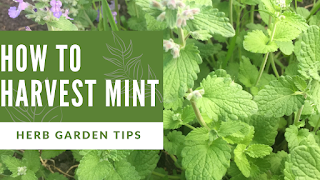Growing, Harvesting and Using Mint From Your Herb Garden
Mint is an easy herb to try if you're just starting out as it is can grow nearly everywhere, thought it prefers sun and it is easy to harvest. Mint can be used in a variety of recipes, teas, potpourri or have oil extracted for topical uses.
Mint is a great source of vitamins A, C, as well as calcium, magnesium, and iron. It can be used to freshen breath, may be able to reduce pain through topical or oral means, and helps to calm digestive complaints. We like it as it seems to keep the flying pests away and keeps the yard smelling fresh. Dried leaves may be used to repel rats and mice. It is often used tea or as a garnish, but pairs especially well with lamb, chicken or rice as well as many other dishes.One of my favorites is a mint & raspberry leaf tea or a standard mojito.
Planting
Plant seeds or plants after last frost of the year in easy draining, but moist soil (think river banks). Ideal soil will have a pH of 6.0-7.0, but mints will likely tolerate slightly outside this range. Mint plants are typically full sun, but will likely grow in the shade in a stunted form (smaller plants). Space plants or seeds 24". You can plant mint either in the ground or in a container. Often times containers may be the best option as mint spreads by runners and can quickly overtake other plants in your yard. Plus, you can move the container indoors to continue growing through the winter. Check your mint variety as some can grow in zones 3, but many will only return in zone 5. We have had good luck with spearmint in zone 4 so far with it returning each spring.
Mint can also be propogated from cuttings. Place cutting in water until roots begin to form. Plant in soil. Six inch cuttings from an established plant work well for either starting in water or planting directly in soil horizontally.
Mint can also be propogated from cuttings. Place cutting in water until roots begin to form. Plant in soil. Six inch cuttings from an established plant work well for either starting in water or planting directly in soil horizontally.
Growing
Mint is a full sun plant. This means 8-10 hours of sunlight a day. It will still grow with much less sun, and even mostly shade, however, your plant growth will be stunted and you may need to wait quite a bit longer to harvest. Indoors, place your planter near a sunny window or use T5 fluorescent plant lights to achieve a full sun effect. Knowing the full sun requirement, choose between ground or container planting. You will want to plant seeds ~6-8 inches apart after the last frost of the year or in the fall to allow the plant to germinate at a time of it's choosing. Water regularly or anytime the soil feels dry to the touch. Mint in containers may not get as tall and will need to be fertilized periodically. Replant every 3-4 year to keep flavor stronger. Mint may grow to 1-2' tall.
Mint is best paired with cabbage and tomatoes as it will improve flavor of the plants. Stinging nettle will also promote mint growth. Mint plants deter cabbageworms while spearmint helps repel ants and aphids from nearby plants. It also helps in general to deter moths and flies. Avoid planting near
Harvest regularly to promote further growth.
Pests
While mint deters most pests, it is subject oto a few issues such as rust, powdery mildew, leaf spot, anthracnose, and stem canker. These can be reduced by picking off any compromised leaves as well as keeping your plant well pruned. If a fungal infection takes root, a copper based fungicide may help, but be careful of over spraying as it can be toxic for earthworms and other microbes.
Harvest
You can pick off the individual leaves or cut the entire stalk an inch from the base. When trimming, be sure to leave ~1/3 of the plant to promote future growth. If flower buds appear, trim immediately to promote further leaf growth. If you want these as edible ornamentals, leave the flowers to enjoy a light purple flowers stalk and pick leaves after. Flavor will not be as strong if allowed to flower first. Most mint plants should allow for at least 3 harvests per season.Storing
Once you've picked your mint, either use immediately, freeze, refrigerate for up to 3 days, or dry. A few methods of drying mint can be used. Keep in mind that drying will reduce flavor, but will be much more flavorful than store bought herbs.
- Dehydrator - follow manufacturer instructions (likely 7 hours at 100 degrees)
- Baking at 350 until crisp
- Hang Dry - Hang mint stalks upside down until dry
- Lay flat on cookie cooling rack, turning periodically until crisp.
Store in airtight container.
For great recipe ideas view Thrifty Cooking posts.
Embed


Comments
Post a Comment